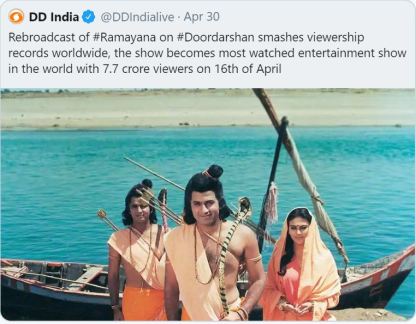
So, the re-telecast of Ramayan after 32 years has concluded with a viewership of 77 million, breaking all world records. Wall Street Journal has ignorantly called it an 80’s show with long ballads and moral lectures. So, here’s an account, a review of the show, and any impact that it might have made on this skeptic.
I belong to a generation that likes to challenge traditions, reason out the rituals, and doubt anything that doesn’t seem to be backed by science or isn’t tangible in one way or another. Unfortunately for us and fortunately for them, the previous generations did not have these qualms and was perfectly fine following what was passed on to them. They ended up following better lifestyles, incorporating better moral values, and leading healthier lives. We ended up with unanswered questions, remained oblivious of the science behind the ‘funny’ traditions, and believed that epics were just fictitious stories with unexplainable sequences and significant character flaws.
I have known the stories from Ramayan all my life; heard it from parents and grandparents, came across incident descriptions on Temple walls; seen and heard references across multiple mediums. I honestly didn’t see the big deal and definitely wasn’t a fan of the protagonist for obvious reasons. How could a man, so unjust towards his wife be portrayed as the ideal man and be prayed to, as divine? Of course, I knew all about Ramayan and had a strong opinion about it.
Of course, I couldn’t be further from the truth. Just like most aspects of our tradition, we got so caught up with the superficial layer, the story, that we missed the treasure within. Unfortunately, even the story we heard, often went through so many interpretations and abridged forms that its essence was completely lost. And we ended up judging an epic, immersed in wisdom, science, and morals, on the basis of a few fragmented incidents of the story.
Ramayan is a beautifully crafted tale with impeccable character compositions, highly intricate descriptions of short stories within and heart touching narrations of complex life situations. With Valmiki’s appearance and Luv Kush’s recital of the tale within the story, it creatively comes full circle like a bow tied on top of a cherished present.
When Doordarshan began the run of Ramanand Sagar’s show and the whole country seemed to be watching it, I too began following it, only in solidarity with the nation.
The pace of the show made me a little impatient in the beginning, for I could not understand why they wouldn’t just get going with what happened next! But that’s when the first realization hit me; it’s not just about Ram’s story, it’s about embodying his values and character. So when the four brothers go to Gurukul, it’s not about the fact that they went out to study, it’s about the education that was imparted to them. From the importance of yoga and Surya Namaskar to the energy flow in the body, from deep life wisdom to the relevance of human emotions, every conversation is meaningful.
The next epiphany that I experienced was with the understanding of Ram. His flawless character is the zenith of kindness, forgiveness, love, respect, righteousness, and patience. I am in awe of him and now I see what the big deal is! Without true knowledge of his character, the critics would judge him, citing the misconstrued incident of him questioning his wife’s character and abandoning her. After an insight into his life long decisions, his compassion, and his empathy, one would argue that it would be totally out of character for Ram to distrust Sita’s devotion.
And rightly so, Ram’s faith in Sita is invincible. His love and respect for her are as true as is her essence. It is she who convinces him that as a leader, his prime responsibility is towards his people and their mandate and that he should let her go. He does not abandon her. Fate separates them. He suffers as much as she does; in my opinion, probably a little more, for he has to also live with the guilt of letting the love of his life go. The whole sequence is wonderfully captured by the show and portrays the intricate details of the emotional turmoil that the lovers go through.
The Epic revolves around various stories of self-sacrifice and loyalty and Dharm; from Lakshman and Urmila to Bharat and Mandavi, each character is an embodiment of love and devotion. One can never appreciate and give due credit to these characters with the half baked stories that we have heard all through. Lakshman often seems to be the voice in my head as he asks the same naive questions and displays the same emotional impatience that arises in me before Ram settles all doubts, unveiling the path of morality and virtue.
The final chapter where Luv Kush hold the people answerable for the injustice done to their mother, the regret that the kingdom feels for their actions, Sita’s final leap into mother Earth and Ram’s moment of frenzy afterward, illustrates that if a woman represents tolerance and sacrifice she also characterizes self-esteem. It’s an important lesson in the value that women should hold in society and the consequences of disrespecting her.
Every event, every heart to heart, throughout the epic, has profound wisdom and life lessons. Through the show, I feel fortunate to have dipped my toes into the ocean of truth and knowledge and to have found the right perspective. If you can get over the graphics from 32 years ago, and appreciate the imagination/creativity from 19 million years ago, Sampoorn Ramayan is a must watch! And probably that would be the starting point for many of us to pick up Ramayan and read and reread it for the rest of our lives!
